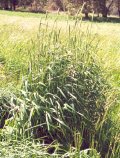
Phalaris

| Pasture type and use | Perennial autumn/winter/spring growing suited to dryland and irrigated grazing. Also used for hay and silage. |
|---|---|
| Area of adaptation | Northern, Central and Southern Tablelands; Central, Southern and Northern Slopes; irrigated areas and some limited coastal use. |
| Min. average annual rainfall | >550 mm (southern NSW) to >600 mm (northern NSW). |
| Advantages |
|
| Disadvantages |
|
| Soil requirements | It is best suited to high-fertility, deep, heavy-textured soils, but soil type, soil depth and grazing management become more critical as rainfall decreases. Phalaris will grow on a wide range of soils, from moderately shallow, moderately acidic, sedimentary soils to deep, self-mulching, alkaline clays. |
| Varieties |
Select varieties on the basis of plant type, need for summer dormancy, seedling vigour, phalaris poisoning potential, acid soil tolerance and local performance data (where available).
* Denotes that this variety is protected by Plant Breeder’s Rights. |
| Sowing rates: | |
| - as only species | 3–5 kg/ha |
| - in mixtures | 1–3 kg/ha |
| Sowing time | Autumn/early winter (March to June). At higher-altitude high-rainfall tableland districts, spring sowings (August to September) can also be successful. |
| Companion species | Legumes (white, red and subterranean clovers, lucerne, lotus) and other temperate grasses (fescue, cocksfoot, ryegrass). |
| Inoculation | N/A |
| Major nutrient deficiencies | Nitrogen, phosphorus and sulfur. |
| Main insect pests | Phalaris pastures are sometimes seriously damaged by blue oat mite, redlegged earth mite, field crickets, pasture scarabs, slugs and snails. |
| Main diseases | Disease rarely causes problems in established phalaris paddocks. |
| Management |
Grazing management is important for satisfactory production and persistence, as well as to maintain legume content of the pasture.
As a general guide, the seasonal strategies outlined below can be used to enhance production and persistence. Where conditions do not permit guidelines to be followed, use the principles as far as is practical in your circumstances, e.g. a 3–4 week rest (rather than 6 weeks) from grazing following the autumn break is better than no rest at all. Summer: In cooler elevated areas, maintain grazing (to about 1200 kg DM/ha (dry matter per hectare)) or slash to promote autumn regrowth and clover regeneration. In ‘summer dry’ environments, some carryover stubble is considered useful. In hotter areas with more erratic rainfall, more carryover feed (e.g. 1500 kg DM/ha) with flowering stems prevents regeneration buds from shooting. Towards the end of summer, where soil erosion is not likely to be a problem, aim at 10–15% of bare ground, to assist establishment of annual legumes. Phalaris leaf litter can adversely affect establishment of sub clover. |
| Livestock disorders of particular note | Sometimes phalaris staggers; occasionally phalaris sudden death syndrome. |
| Additional tips | Establishment problems are often encountered, frequently associated with slow early growth. Weed competition, sowing depth, sowing time and soil nutrition are particularly important. |
| Further information |
|
More information
- Phalaris (Primefact 1540)
- Phalaris Pastures (Agfact P2.5.1 )
- Introduction to selecting pastures in NSW (Primefact 1539)
Acknowledgments
Advice on livestock health disorders was provided by Dr Chris Bourke, Principal Research Scientist, NSW Agriculture, Orange. His contribution is gratefully acknowledged.
Photo: Clare Edwards, NSW Agriculture, Armidale

